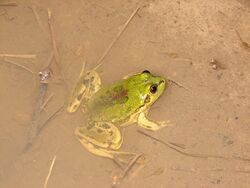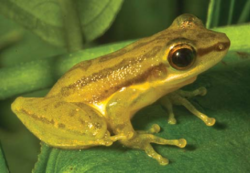Biology:Pseudinae
| Pseudinae | |
|---|---|

| |
| Pseudis bolbodactyla | |
| Scientific classification | |
| Domain: | Eukaryota |
| Kingdom: | Animalia |
| Phylum: | Chordata |
| Class: | Amphibia |
| Order: | Anura |
| Family: | Hylidae |
| Subfamily: | Pseudinae Fitzinger, 1843 |
| Type genus | |
| Pseudis Wagler, 1830
| |
| Genera | |
|
3 genera (see text) | |
Pseudinae is a subfamily of neotropical frogs in the family Hylidae.[1][2] They are distributed all throughout the tropical and subtropical parts of South America east of the Andes, including Trinidad, all the way down to Uruguay and adjacent parts of Argentina .[1][3]
They are notable because despite being tree frogs, they have convergently evolved with true frogs and have lost most of their tree dwelling traits, becoming semi-aquatic or aquatic.[3] Their name references this similarilty, with Pseudinae coming from the Greek ψεῦδος (pseudos) which means "false" or "pretending".
In the wild they are preyed on by a variety of animals, including aquatic insects, spiders, and birds such as the buff-necked ibis and large-billed tern.[4]
Genera
There are three genera and thirteen species within Pseudinae:[1][2][3]
- William Edward Duellman and de Sá, 1988 Cope, 1862
- Pseudis Lysapsus
- Wagler, 1830 Scarthyla
These frogs have a chromosome component of 2n = 24, the exceptions being Scarthyla goinorum with 2n = 22 and Pseudis cardosoi with 2n = 28.[3]
Morphology and evolution
Pseudine frogs are unique for Hylid frogs because of how different they are in their morphology. While Hylids are generally adapted to living in trees, Pseudine frogs have adapted to aquatic lifestyles and such have lost much of their tree climbing abilities. This is evident in how the intercalary elements, which are the spaces in between a frog's digits, have become ossified in order to strengthen them and help them swim in the water more efficiently. Normally in tree frogs, these intercalary elements remain unossified in order to allow their hands and feet to be flexible.[3][5] They also have a unique ligament cap that connects their knee to their pelvis that has not yet been seen in any other type of frog.[6]
The sister taxon of Pseudinae is Dendropsophinae, splitting apart from them during early Oligocene 25.8–38.7 Mya. This family remained tree frogs and diversified greatly, while Pseudine frogs transitioned to aquatic ecosystems. Scarthyla is the oldest and most Hylid-like of the Pseudines, originating in the central Amazon basin and being restricted to the Guiana region in modern times. Lysapsus and Pseudis diverged during the early Miocene 18.4–24.6 Mya and have since spread down to the Chaco region that is drier and less suited for most tree frogs.[3]
References
- ↑ 1.0 1.1 1.2 "Pseudinae Fitzinger, 1843". https://amphibiansoftheworld.amnh.org/Amphibia/Anura/Hylidae/Pseudinae.
- ↑ 2.0 2.1 "Pseudinae Fitzinger, 1843". https://www.catalogueoflife.org/data/taxon/K7Z.
- ↑ 3.0 3.1 3.2 3.3 3.4 3.5 Duellman (19 April 2016). "Phylogenetics, classification, and biogeography of the treefrogs (Amphibia: Anura: Arboranae)". Zootaxa 4104 (1): 1–109. doi:10.11646/zootaxa.4104.1.1. PMID 27394762. http://www.cnah.org/pdf/88524.pdf.
- ↑ Filho (April 2019). "Escape or be Preyed: New Records and Current Knowledge on Predators of Pseudinae Frogs (Anura: Hylidae) in South America". Acta Biológica Colombiana 24 (2): 397–402. doi:10.15446/abc.v24n2.74650. https://www.researchgate.net/publication/332763973.
- ↑ Manzano (December 2007). "Intercalary elements, treefrogs, and the early differentiation of a complex system in the Neobatrachia". The Anatomical Record 290 (12): 1551–1567. doi:10.1002/ar.20608. PMID 17957750. https://anatomypubs.onlinelibrary.wiley.com/doi/10.1002/ar.20608.
- ↑ Manzano (September 2005). "The iliosacral articulation in Pseudinae (Anura : Hylidae)". Herpetologica 61 (3): 259–267. doi:10.1655/04-28.1. https://www.researchgate.net/publication/250069333.
Wikidata ☰ Q27975528 entry


